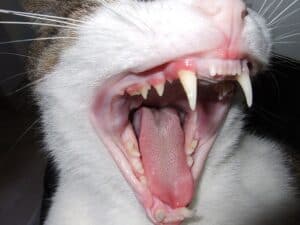Cats have sharp canines because they are carnivorous creatures. But do felines have such sharp teeth from birth, or do they acquire them later in life? It’s worth looking into.
Cats are born without visible teeth and have two sets of teeth in succession. Here is a table that illustrates whether cats have teeth at birth by comparing Bengal cats to other domestic cats.
| Tooth Facts | Bengal Cats | Domestic Cats |
| Possess sharp teeth | Yes | Yes |
| Number of permanent teeth | 30 (on average) | 30 (on average) |
| Born with teeth | No | No |
| Have sharp fangs | Yes | Yes |

several other cat-tooth facts are interesting to learn about, so this is not the conclusion of the story. In this piece, we’ll also discuss whether cats are born with teeth.
Are cats born with all their teeth?
Human teeth and cat teething habits are very similar. They are diphyodont creatures, meaning they have two sets of teeth: permanent teeth and deciduous or milk teeth.
Cats are also born toothless, much like newborn humans. When a kitten is between two and four weeks old, its first baby teeth start to erupt. Here is a timeline for teething in kittens for your reference.
| Teething Pattern | Kitten’s Age |
| No teeth | 0-2 weeks |
| First milk teeth | 2-4 weeks |
| Baby teeth continue to grow until all 26 teeth are present | 5-6 weeks |
| Starts losing milk teeth | 11 weeks |
| Mature teeth start growing | 3-4 months |
| Permanent teeth continue to grow | 6 months |
| All 30 permanent teeth grow by this time | 6-7 months |
Can cats born without teeth?
A healthy set of teeth is always necessary for a healthy mouth. And to keep your cat’s teeth healthy, it is essential to understand their teeth while they are still kittens.
Cats are toothless at birth. However, you can detect teething in cats between 2-4 weeks. Cats first develop their milk teeth, which they begin to lose at 11 weeks and are then eventually replaced by their permanent teeth.
Signs that a kitten is teething
Every cat owner is aware that their pets display specific signs and symptoms during the teething process. Throughout this age, they also exhibit a change in their outward behavior.
These typical indications of kitten teething include:
- Missing teeth
- A loss of appetite
- Increased chewing tendencies
- Pawing at the mouth
- Irritable behavior
- Gum bleeding (maybe)
- Decreased self-grooming
- Sore and red gums
- Feeling discomfort when their face is touched
The symptoms mentioned above are typical of teething in kittens, but cat owners should also check to see if their pets are experiencing dental problems . Furthermore, remember that kittens occasionally might not lose all of their milk teeth. Even if it’s uncommon, you might need to take your cat to the clinic for such conditions.
The duration of a cat’s teething
Teething in a cat are the beginning of a new chapter in its life. Both the kitten and its humans undergo certain changes during this period. So, it’s worth noting how long this period could last.
The teeth process in kittens starts when they are at least 2 weeks old. This process can stretch up to 4 weeks. By 6 weeks, a typical kitten should grow all its milk teeth.
Although duration differs amongst cats just as much as it does between humans, the above-outlined timeline largely holds true.
Why do cats’ teeth fall out?
Losing teeth is completely natural for kittens. But the reason for their teeth falling out is still a mystery.
Kittens lose milk teeth, and permanent teeth take their place. The procedure is comparable to what occurs with human newborns. The timeline is entirely different, though.
However, it is important to remember that there may be other factors at play in this situation if an cat’s teeth fall out. Although cats seldom get cavities, they can still develop other dental problems.
Therefore, it is important to keep a close eye on your cat’s teeth and check to see if it has any dental problems. To prevent any significant dental issues, it is also critical to keep a constant eye on your kitten’s teeth while they are teething.
Do kittens have baby fangs?

Cats are carnivores. Hence fangs are essential to their existence. They are essential when attacking prey and predators because they rip flesh with fangs.
Kittens also develop baby or milk fangs along with their milk teeth. These fangs frequently have an almost needle-tip sharp point. Though kittens gradually shed them in favor of permanent fangs.
Is teething a painful process?
Just like with human infants, teething is a normal part of life for cats. But a concern for cat lovers is whether or not cats experience discomfort when they are teething.
Experts claim that while kittens go through the teething process without necessarily experiencing pain, they experience some discomfort. A cat’s gums will typically swell when they grow new teeth, which could make their face sore and sensitive.
Teething Kittens exhibit a lack of interest in food because of their sensitivity. Your cat may also seek something to gnaw on to ease the discomfort. You might also see your cat drooling or catch a whiff of something strange coming from its mouth.
Having stated that, all of these problems will go as soon as the new teeth appear.
Do cats swallow their baby teeth?
Cats are not as conscious beings as humans. So, it is not abnormal if they swallow their baby teeth. But is there any reality behind this?
Kittens frequently swallow their baby teeth while teething.
Why are cats’ fangs so long?

Feline fangs are essential to their ability to survive. But not every cat has the same size fangs. Some of them have long, pointed fangs. But why do creatures have long fangs?
A cat’s fangs are typically 1 cm long. Because they require them to rip their food, cats have large fangs. Molars are not present in felines. They must therefore rip their food before eating it because they are unable to chew it.
Cats’ large fangs serve the additional function of serving as “bleeding grooves.” This means that cats are guarded against choking on the blood and flesh of their prey or predator while attacking them.
The size of the fangs, however, is not particularly significant. One of the deadliest hunters in the wild, the black-footed cat, the smallest breed of all the large cats, has smaller fangs. Additionally, having longer-than-average fangs does not necessarily indicate that a cat is aberrant. Just marvel at how lovely they look with any size of fangs.
How many fangs do cats have?
Cats must consume meat in order to thrive, making them obligate carnivores. They need fangs since they are designed for hunting for food.
Typically, cats have four canines or fangs. Those “fangs” frequently stick out in saber-tooth tiger fashion.
Summary
So, this was our take on if cats are born with teeth. The bottom line of the investigation is that cats are not born with teeth. Rather they grow their milk teeth when they are around 4 weeks old. Permanent teeth eventually replace the milk teeth. The feline teething cycle is much similar to that of humans. And cat owners can make the teething process comfortable for their pets by providing them with chewing toys, suitable food, and lots of care.




